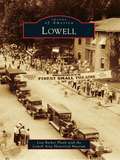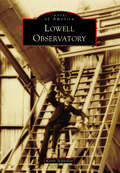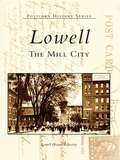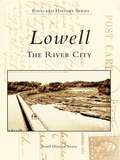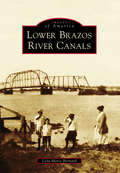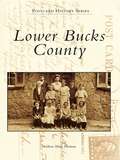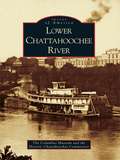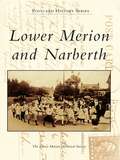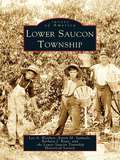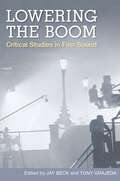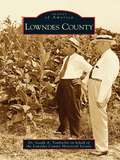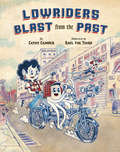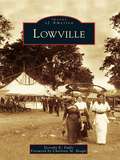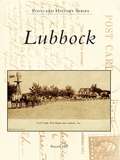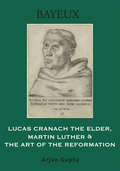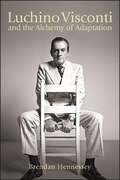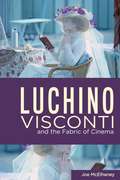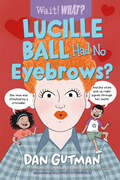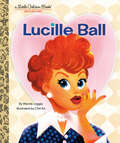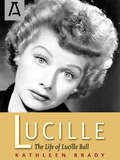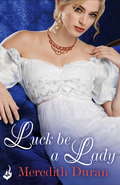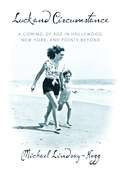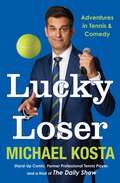- Table View
- List View
Lowell
by Lisa Barker Plank Lowell Area Historical MuseumSettlement of the Lowell area centered on the confluence of the Grand and Flat Rivers. Joseph and Magdaleine LaFramboise first established a fur trading post near the Ottawa village, Segwun, where the rivers meet. The community grew as settlers poured into the area attracted by the growing lumber industry and rich farmland. Diverse businesses emerged including a cutter factory, a vibrant clamming industry, and the state's oldest family-run flour mill. A unique feature of the area is Fallasburg Historic Village. Once an active mill town on the Flat River, Fallasburg slid into obscurity when the railroad passed it by. At the height of the Great Depression, businessmen of Lowell joined together to build a showboat to draw visitors to town. The Lowell Showboat is now one of the most recognizable attractions in Lowell. This book explores both well known and more obscure aspects of Lowell's history through a wealth of images, many never published before.
Lowell Irish: Stories & Accounts Of Lowell's Early Irish (American Heritage)
by David D. MckeanIrish immigrants streamed into the mills of Lowell, Massachusetts, at the start of the Industrial Revolution, fleeing poverty and later the Great Hunger. Irish families established a neighborhood called the Acre, and some rose to roles as successful business owners who shaped the history of their new home. Hugh Cummiskey emigrated from Northern Ireland to become a powerful work gang leader and businessman who in turn hired newly arrived immigrants. The first recorded celebrations of St. Patrick's Day began in 1833, as new residents celebrated their Irish roots and American future with traditional music and parades. Today, the community still honors its Irish history. From tales of politicians and entrepreneurs to the everyday struggles of the average immigrant, author David McKean traces the history of the pioneer members who established Lowell as an industrial powerhouse.
Lowell Observatory: A History Of Discovery At Flagstaff (Images of America)
by Kevin SchindlerAtop a mesa one mile west of downtown Flagstaff, Arizona, sits Lowell Observatory, an astronomical research facility steeped in tradition. Percival Lowell, scion of a Boston Brahmin family, initially established his observatory in 1894 to study the possibility of intelligent life on Mars. Lowell widely popularized his controversial theories, sparking debate among both the scientific community and lay public. In the following years, the observatory's astronomers made several discoveries that dramatically altered our understanding of space, including Clyde Tombaugh's discovery of Pluto in 1930 and V.M. Slipher's detection of the expanding nature of the universe in 1912. Decades later, Apollo astronauts visited as part of their training to fly to the moon. These stories and others offer a glimpse of the scientific discovery, community pride, and personal triumph that define Lowell Observatory.
Lowell: The Mill City
by Lowell Historical SocietyFrom its birth in 1826, Lowell has thrived, declined, and been resurrected as a mill city. Today, it is celebrated for its rich history. These postcards from the 1890s to the 1940s display the energy of this industrial city and its native andimmigrant population as it grew, built, worked, and played. Vintage cards capture both familiar mills along the Merrimack River and vanished businesses. Coupled with compelling narrative, they tell stories of a horse-drawn fire engine, textile mill workers, grand civic buildings, floods,and even the aftermath of an explosion.
Lowell: The River City
by Lowell Historical SocietyLowell, a historic industrial city, owes its life to the broad Merrimack River. Renowned for its water-powered textile mills, it was also a city rich in natural beauty, where spiritual and cultural values took root. Postcards from the 1890s to the 1940s bear witness to riverscapes, varied waterways, arched bridges, and green parks. Vintage cards depict grand churches and stately mansions, some now altered or gone, and rare interior views. Informative text accompanies the images of yellowbricked colleges, pastoral neighboring environs, dignified cemeteries, and imposing monuments, such as the captivating Lion Monument.
Lower Brazos River Canals
by Lora-Marie BernardCommunities have spent more than 100 years mastering the mighty Brazos River and its waterways. In the 1800s, Stephen F. Austin chose the Brazos River as the site for the first Texas colony because of its vast water and fertile soil. Within 75 years, a pumping station would herald the way for crop management. A sugar mill that was eventually known as Imperial Sugar spurred community development. In 1903, John Miles Frost Jr. tapped the Brazos to expand the Cane and Rice Belt Irrigation System while Houston newspapers predicted the infrastructure marvel would change the region's future--and it did. Within a few decades, the Texas agricultural empire caused Louisiana to dub Texas farmers "the sugar and rice aristocracy." As the dawn of the industrial age began, the Brazos River and its waterways began supplying the Texas Gulf Coast industry.
Lower Bucks County (Postcard History)
by Andrew Mark HermanNamed by William Penn in 1681, Bucks County is one of the three original counties in Pennsylvania and enjoys a lengthy tradition as an important region of this state. Lower Bucks County is a fascinating pictorial history of the towns that comprise the northern suburban edge of Philadelphia. Surveying the era from 1905 to 1970, the book includes images from the towns of Langhorne, Hulmeville, Trevose, Southampton, Newtown, Tullytown, Richboro, Churchville, Holland, Cornwells Heights, Fallsington, Yardley, Feasterville, Bristol, Oxford Valley, Parkland, and Andalusia. Lower Bucks County portrays the natural beauty of the area's scenery, as well as historic homes, hotels, stores, and schools. Several prominent families are also chronicled, as the county evolves into the bustling communities of today.
Lower Chattahoochee River
by The Columbus Museum Historic Chattahoochee CommissionThe Chattahoochee River has dramatically shaped the heritage of the lower Chattahoochee Valley of east and southeast Alabama and west and southwest Georgia. As the region's dominant geographic feature, the Chattahoochee has served residents of the area as an engine for commerce and as an important transportation route for centuries. It has also been a natural and recreational resource, as well as an inspiration for creativity. From the stream's role as one of the South's busiest trade routes to the dynamic array of water-powered industry it made possible, the river has been at the very center of the forces that have shaped the unique character of the area. A vital part of the community's past, present, and future, it binds the Chattahoochee Valley together as a distinctive region. Through a variety of images, including historic photographs, postcards, and artwork, this book illustrates the importance of the Chattahoochee River to the region it has helped sustain.
Lower Merion and Narberth (Postcard History)
by The Lower Merion Historical SocietyFirst settled in 1682 by William Penn's coterie of Welsh Quakers, the Lower Merion area has since undergone several transformations: from farmland, to the home of Philadelphia's industrial elite, to built-out suburb. Besides the development of the unique and impressive Main Line mansions for which the area is famous, Lower Merion and Narberth have been the scene of dramatic railroad rivalries and advances for the middle class. Lower Merion and Narberth focuses on the era of the most intense development, between 1900 and 1950, when the character of each individual neighborhood was coming into its own.
Lower Saucon Township (Images of America)
by Karen M. Samuels Lee A. Weidner Barbara J. Ryan Lower Saucon Township Historical SocietyLower Saucon Township provides a unique glimpse of the region's many diverse villages and the German immigrant population. Towns including Wassergass, Shimersville, Polk Valley, Redington, and Bingen were settled largely because of the area's fertile soil, abundant water, and many iron and limestone deposits, which contributed to surrounding communities such as Bethlehem and Hellertown both socially and economically. These rare family photographs depict a blend of lives that influenced the area before and after the industrial revolution.
Lowering the Boom: Critical Studies in Film Sound
by Jay BeckAs the first collection of new work on sound and cinema in over a decade, Lowering the Boom addresses the expanding field of film sound theory and its significance in rethinking historical models of film analysis. The contributors consider the ways in which musical expression, scoring, voice-over narration, and ambient noise affect identity formation and subjectivity. Lowering the Boom also analyzes how shifting modulation of the spoken word in cinema results in variations in audience interpretation. Introducing new methods of thinking about the interaction of sound and music in films, this volume also details avant-garde film sound, which is characterized by a distinct break from the narratively based sound practices of mainstream cinema. This interdisciplinary, global approach to the theory and history of film sound opens the eyes and ears of film scholars, practitioners, and students to film's true audio-visual nature. Contributors are Jay Beck, John Belton, Clark Farmer, Paul Grainge, Tony Grajeda, David T. Johnson, Anahid Kassabian, David Laderman, James Lastra, Arnt Maasø, Matthew Malsky, Barry Mauer, Robert Miklitsch, Nancy Newman, Melissa Ragona, Petr Szczepanik, Paul Théberge, and Debra White-Stanley.
Lowndes County (Images of America)
by Lowndes County Historical Society Dr Joseph TomberlinLowndes County, located deep in the wiregrass region of southern Georgia, has been continuously occupied since ancient times. Through the centuries, various Native American tribes inhabited the region, but they lingered relatively briefly and left few tangible traces. The area's written history began with the establishment around 1623 of the Spanish mission of Santa Cruz de Cachipile in southern Lowndes. Georgia's general assembly created Lowndes County from the southern half of Irwin County in 1825 and named it for William Jones Lowndes of South Carolina. The present county seat, Valdosta, dates from the construction of the Atlantic and Gulf Railroad across Lowndes from 1859 to 1860. Ultimately the county was to have five railroads, which, combined with U.S. Highways 41 and 84 and Interstate 75, were to be major factors in dramatic local growth."
Lowriders Blast from the Past (Lowriders)
by Cathy CamperWhen new friends Lupe, Flapjack, and Elirio are each bullied by Las Matamoscas, they know they're going to like one another. When they find out they all love lowrider cars, they know they'll be friends for life. But the bullies won't leave the Lowriders alone—and they don't let any girls or babies into car clubs. Can these three determined outcasts prove they deserve to be in the car show? Humor, Spanish words, and lowrider culture come together in this heartwarming graphic novel of three friends navigating the bumpy terrain of friendship, bullying, and standing up for what you believe in. ¡Vámonos!
Lowville
by Charlotte M. Beagle Dorothy K. DufloLowville, first settled in 1796, is part of the Black River valley, an area laden with fertile land and rich forests. The town continued to develop through the years, supporting hotels, flour mills and gristmills, furniture manufacturers, cheese plants, tanneries, and even a brewery. Lowville's place in history was sealed when, by 1878, it was producing eight million pounds of cheese annually with a value at that time of $1 million. The earlier manufacturing businesses gradually faded, and Lowville ushered in the 20th century as an important dairy center, a tradition that continues to this day.
Lozioni e creme corpo
by Ashley Andrews Elèna DeufemiaUn libro su come creare da te le tue lozioni partendo da zero. Una guida simpatica e divertente nel mondo della cosmesi e dei trucchi di bellezza alla portata di tutti!
Lubbock
by Russell HillThe city of Lubbock began as a compromise between two smaller settlements known as Lubbock and Monterey. These settlements agreed to combine on December 19, 1890, and by 1891 the combined settlement was elected the new county seat as farmers, ranchers, and settlers began to arrive. In 1909, Lubbock incorporated as a city, and the Santa Fe Railroad sent its first train south from Plainview. The Texas Legislature authorized the establishment of Texas Technological College in 1923, and Lubbock won the regional contest for the new university's location. Today Lubbock is the 10th-largest city in Texas, with an estimated population of 230,000. The Lubbock economy thrives on agriculture, education, manufacturing, and health industries.
Lucas Cranach the Elder, Martin Luther, and the Art of the Reformation
by Arjun GuptaMartin Luther's amazing courage and intellect come to life against the backdrop of paintings by Lucas Cranach the Elder, possibly the greatest artist of the European Reformation. This is the second volume in Bayeux's series entitled STORIES BEHIND THE ART.
Luchino Visconti and the Alchemy of Adaptation (SUNY series, Horizons of Cinema)
by Brendan HennesseySince the beginning, much of Italian cinema has been sustained by transforming literature into moving images. This tradition of literary adaptation continues today, challenging artistic form and practice by pressuring the boundaries that traditionally separate film from its sister arts. In the twentieth century, director Luchino Visconti is a keystone figure in Italy's evolving art of adaptation. From the tumultuous years of Fascism and postwar Neorealism, through the blockbuster decade of the 1960s, into the arthouse masterpieces of the 1970s, Visconti's adaptations marked a distinct pathway of the Italian cinematic imagination. Luchino Visconti and the Alchemy of Adaptation examines these films together with their literary antecedents. Moving past strict book-to-film comparisons, it ponders how literary texts encounter and interact with a history of cultural and cinematic forms, genres, and traditions. Matching the major critical concerns of the postwar period (realism, political filmmaking, cinematic modernism) with more recent notions of adaptation and intermediality, this book reviews how one of Italy's greatest directors mined literary ore for cinematic inspiration.
Luchino Visconti and the Fabric of Cinema (Queer Screens)
by Joe McElhaneyIn Luchino Visconti and the Fabric of Cinema, Joe McElhaney situates Visconti’s films as privileged and deeply expressive instances of a trope that McElhaney identifies as the "cinema of fabric": a reoccurrence in film in which textiles—clothing, curtains, tablecloths, bedsheets—determine the filming process. An Italian neorealist, Visconti emerges out of a movement immediately following WWII wherein fabric assumes crucial functions, yet Visconti’s use of fabric surpasses his colleagues in many ways, including its fluid, multifaceted articulations of space and time. Visconti’s homosexuality is central to this theory in that it assumes metaphoric potential in addressing "forbidden" sexual desires that are made visible in the films. Visconti’s cinema of fabric gives voice to desires not simply for human bodies draped in fabric but also for entire environments, a world of the senses in which fabric becomes a crucial method for giving form to such desires. McElhaney examines Visconti’s neorealist origins in Ossessione, La terra trema, and Rocco and His Brothers, particularly through fabric’s function within literary realism and naturalism. Neorealist revisionism through the extravagant drapings of the diva film is examined in Bellissima and Senso whereas White Nights and The Stranger are examined for the theatricalizing through fabric of their literary sources. Visconti’s interest in German culture vis-à-vis The Damned, Death in Venice, and Ludwig, is articulated through a complex intertwining of fabric, aesthetics, politics, and transgressive sexual desire. Finally, Visconti’s final two films, Conversation Piece and The Innocent, assess through fabric both the origins of Italian fascism and the political tensions contemporaneous with the films’ productions. Fabric in Visconti is often tied to the aesthetic impulse itself in a world of visionaries attempting to dominate their surrounding environments and where a single piece of fabric may come to represent the raw material for creation. This book will tantalize any reader with a keen eye and strong interest in film and queer studies.
Lucille Ball Had No Eyebrows? (Wait! What? #0)
by Dan GutmanFrom the best-selling author of My Weird School: a new entry in the cheerful and engaging biography series centered on high-interest historic figures. Did you know that Lucille Ball could pick up radio signals through her teeth? Or that her career was almost destroyed because she was a registered Communist? Bet you didn’t know that, as a studio executive, she green-lit both Star Trek and Mission: Impossible! Siblings Paige and Turner have collected some of the most unusual and surprising facts about the beloved actress, from her impoverished childhood and her first forays into the film industry to her marriage with Desi Arnaz and her rise to become both the most prominent actress in television and one of its most successful executives. Narrated by the two spirited siblings and animated by Allison Steinfeld’s upbeat illustrations, Wait! What? Lucille Ball Had No Eyebrows? is an authoritative, accessible, and one-of-a-kind biography infused with Dan Gutman’s signature zany sense of humor.
Lucille Ball: A Little Golden Book Biography (Little Golden Book)
by Wendy LoggiaHelp your little one dream big with a Little Golden Book biography about Lucille Ball--and find out why everyone loves Lucy! It's the perfect introduction to nonfiction for preschoolers.This Little Golden Book about Lucille Ball--television star, comedian, producer, and the first woman to own a major studio--is a celebration of a true trailblazer! It's a great read-aloud for young children, as well as their parents and grandparents who grew up watching and loving I Love Lucy.Look for Little Golden Book biographies about these other inspiring people:Dwayne JohnsonQueen Elizabeth II Barack ObamaSonia Sotomayor Dr. FauciJoe BidenDolly PartonKamala HarrisMisty CopelandBetty WhiteFrida KahloRuth Bader GinsburgJackie RobinsonMartin Luther King Jr.
Lucille: The Life of Lucille Ball
by Kathleen BradyEveryone loved Lucy, the scheming, madcap redhead who ruled television for more than twenty years. In life, however, Lucille Ball presented a far more complex and contradictory personality than was ever embodied by the television Lucy. In Lucille: The Life of Lucille Ball Kathleen Brady presents the actress as a fully rounded human being, often at odds with the image she presented as an entertainment icon. Brady has gone far beyond the typical celebrity biography to present a funny, unflinching and ultimately moving portrait of Lucille Ball as a performing artist, daughter, mother, friend, colleague, and television mogul. Many think they know the story of Lucille Ball's life, but Brady provides new details and a fresh perspective on this complex woman through a wealth of anecdotes and firsthand accounts. Lucille Ball is revealed not only as a television archetype and influential icon of postwar American culture, but as a driven yet fragile human being who spent her life struggling to create of life of normalcy, but ultimately failed--even as she succeeded in bringing laughter of millions of fans. In researching Lucille, Brady interviewed more than 150 people from her hometown to Hollywood. She spoke with her grade school classmates, and those like Katherine Hepburn and Ginger Rodgers who met her when she arrived in Hollywood in the 1930s. She gained insights from those who knew her before her fame and from those she loved throughout her life. Film, radio and television history come to life with the appearances on these pages of such greats as The Marx Brothers, Buster Keaton, Louis B. Mayer, and of course Desi Arnaz, who march and pratfall through the pages of this outstanding biography.
Luck Be A Lady: Rules for the Reckless 4 (Rules for the Reckless #5)
by Meredith DuranMeredith Duran returns with another witty, humorous and smart romance in the fourth book of her Rules for the Reckless series. Fans of Julia Quinn, Jane Feather and Eloisa James will delight in Meredith's trademark headstrong heroine, cunning hero and tale of deep emotional intensity!Enter Eveleigh's Auction Rooms at your own risk. Prepare to part with your fortune...and lose your heart.They call her the Ice Queen. Catherine Everleigh is London's loveliest heiress, but a bitter lesson in heartbreak has taught her to keep to herself. All she desires is her birthright - the auction house that was mercilessly stolen from her. To win this war, she'll need a powerful ally. Who better than infamous crime lord Nicholas O'Shea? A marriage of convenience will serve them both.Having conquered the city's underworld, Nick seeks a new challenge. Marrying Catherine will give him the guise of legitimacy and access to her elite world - no one need know he's coveted her for a year now. Their arrangement is strictly business, free from the weakness of love. Seduction, however, is an altogether different matter - an enticing game that he's determined she'll play, and what's more, enjoy... Want more Rules for the Reckless? Don't miss Your Wicked Heart or Fool Me Twice.
Luck and Circumstance: A Coming of Age in Hollywood, New York, and Points Beyond
by Michael Lindsay-HoggFrom acclaimed director Michael Lindsay-Hogg (The Normal Heart, The Beatles' Let It Be, Brideshead Revisited, The Rolling Stones Rock and Roll Circus, etc.), son of glamorous Warner's movie star Geraldine Fitzgerald: a magical dreamscape memoir of his boyhood, coming-of-age, and making his way in the worlds of theater, film, and television. Lindsay-Hogg's father, an English baronet from a family whose money came from the China trade, lived in Ireland and was rarely seen by his son. The author's stepfather was the scion of the Isidor Straus fortune, co-owner of R. H. Macy's; Straus went down with the Titanic, and the author's stepfather was, alas, fortune-less. The author's mother, Geraldine Fitzgerald, the redheaded Irish seductress who won instant acclaim as Bette Davis's best friend in Dark Victory and in William Wyler's Wuthering Heights, spent time with Hollywood's elite--Laurence Olivier, Charles Chaplin, and Orson Welles, with whom she worked in New York at the Mercury Theater and in other productions. Lindsay-Hogg writes of how he wented his way into this exotic, mysterious, and seductive world, encountering as a small boy the likes of Marion Davies and William Randolph Hearst, playing hide-and-seek with Olivia de Havilland, serving drinks to Humphrey Bogart, discussing life with Henry Miller. At the book's center, an offhand comment made to Lindsay-Hogg by his mother, when he was sixteen, about talk circulating (false, she claimed) that she had had a romantic relationship with Orson Welles (Fitzgerald and Welles had lived together at his home in Beverly Hills) and that Welles, rumor had it, was Michael's father ("It's not true," she said. "You know how people put two and two together and get three . . ."). That was the end of the conversation. ("It's time for bed . . . You have school in the morning . . ." she said.) For Lindsay-Hogg, it opened up a whole new realm of his life. He was forever changed by the knowing--of not knowing. Interwoven throughout his narrative is the element of questioning who his father was. Was he the patron saint of American pictures, the legendary genius of the twentieth century, Orson Welles, a consistently inconsistent person in Michael's life . . . or was he the man who considered himself Michael's real father? What did his "father" know? What did Welles know? And what did his mother know to be true (she had brought the author up to believe that she always told the truth)? And when would she tell her son what the truth was . . . As Lindsay-Hogg struggled to make sense of it all, questions of missed chances, conversations never had, questions of what is withheld and what is true took root, dogging him, shaping his life . . . questions still, that haunt and inform this moving, deft, and illuminating memoir.From the Hardcover edition.
Lucky Loser: Adventures in Tennis and Comedy
by Michael KostaFrom a host of The Daily Show and stand-up comic, Michael Kosta, comes a wildly funny and insightful memoir about his unlikely journey from professional tennis player (#864 in the world) to professional comedian (there’s no ranking system in comedy but he’s probably . . . top 50?). Before Michael Kosta was performing stand-up comedy specials and hosting The Daily Show, he was a professional tennis “star,” reaching the lofty heights of the #864 ranked men’s singles player in the world. Stop laughing. That’s better than your world ranking. As a tennis pro, Kosta traveled across the globe, competing in such exotic locales as the Netherlands, Tokyo, and even rural Illinois before deciding to put down his racket and pursue a more stable and predictable career: comedy.In a completely unexpected and wild journey through the backwaters of professional tennis, Kosta shows the unlikely ways life on the court prepared him for life in front of a microphone. Like comedy, tennis is brutally competitive, and most people lose at it. Unlike comedy, no one in tennis puts a gun on the table as they count out your earnings in twenty-dollar bills at the end of the night.And then there are the things that have more to do with what happens to you—and what you end up learning—as part of growing up. Topics include: how to properly discard an unwanted European hard-boiled egg, giving CPR to your dead grandpa, cringe-worthy “sex” in the Red Light District, crying so hard in a car that strangers call the cops, and also happy things like what it feels like when your dreams come true. From misadventures in tennis to the humbling setbacks of comedy, Lucky Loser is a heart-filled story of making your own luck, the universal experience of failure, and the many ways in which we all inevitably lose on the way to success.Lucky Loser includes a 16-page photo insert.
